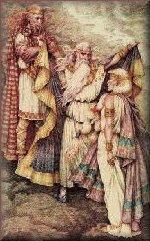Yes, you do sound pendantic and no, I don't agree with you. You are not the sole board member here with an educational background or speciality in Celtic matters. These traditions are also more than textbook examples or history lessons to me but family heritage, handed down over many generations. Let's agree to disagree. And, no, I don't refer to the Compre de Cuchalllian but the Tain Bo Cualnge or The Cattle Raid of Cooley. If you are not familiar with that particular work, then perhaps you should study further.
Information that comes not from my opinion includes:
From the Encyclopedia Labor Law Talk online:
The
banshee (ban'shē) in
Irish mythology is derived from the
Gaelic bean-sidhe (Mod. Ir. "bean s, meaning "spirit woman". They are remnants of the
Tuatha de Danaan. Traditionally some
Irish families had a banshee associated with them, and the banshee might make an appearance before a death in the family. The banshee is particularly well known for a mournful cry or wail by which this death is heralded. Some traditions distinguish between seeing and hearing the banshee; hearing of this "banshee's wail" as predicting a death in the family, and seeing the banshee portents one's own death. She is invariably dressed in white, with long fair hair which she brushes with a silver comb.
From a Vassar hosted site:
The Cattle-Raid of Cooley (Táin Bó Cúalnge) is the central epic of the Ulster cycle. Queen Medb of Connaught gathers an army in order to gain possession of the most famous bull in Ireland, which is the property of Daire, a chieftain of Ulster. Because the men of Ulster are afflicted by a debilitating curse, the seventeen-year-old Cuchulain must defend Ulster single-handedly. The
battle between Cuchulain and his friend Ferdiad is one of the most famous passages in early Irish literature.
From the Celtic Society:
The Sidhe (shee) are considered to be a distinct race, quite separate from humanbeings yet who have had much contact with mortals over the centuries, and there are many documented testimonies to this. Belief in this race of beings who have powers beyond those of men to move quickly through the air and change their shape at will once played a huge part in the lives of people living in rural Ireland and Scotland.-It is difficult to pin-point an exact historical era as the time when fairy lore began.
- Many writers maintain that the people of Ireland and their Gods before the coming of the Gaels are the 'ancestors' of the sidhe. Clearly the belief in the sidhe is part of the pre-Christian religion which survived for thousands of years and which has never been completely wiped out from the minds of the people. When the first Gaels, the sons of Mil, arrived in Ireland, they found that the Tuatha De Danaan, the people of the goddess Dana, already had control of the land. The sons of Mil fought them in battle and defeated them, driving them 'underground' where it is said they remain to this day in the hollow hills or sidhe mounds. In the early Irish manuscripts (which were recorded from an earlier oral tradition) we find references to the Tuatha De Danaan.In 'The Book of the Dun Cow' and the 'Book of Leinster' this race of beings is described as "gods and not gods", pointing to the fact that they are 'something in between'. Also in the Book of the Dun Cow it says of wise men that: "it seems likely to them that they [the Tuatha De Danaan] came from heaven, on account of their intelligence and excellence of their knowledge".
-
- The hold that the Tuatha De Danaan had on the Irish mind was so strong that the new religion of Christianity could not shake it. In 'The Colloquy of the Ancients' a dialogue which supposedly took place between St. Patrick and the ghost of Caeilte of the Fianna, Patrick is amazed to see a fairy woman coming out of the cave of Cruachan, wearing a green mantle with a crown of gold on her head.
As in any field of study, there are obviously different schools of thought.




